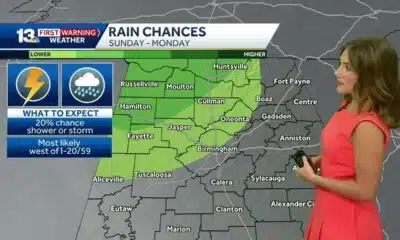News from the South - North Carolina News Feed
Rebuild Western NC with resilience. Listen to residents near rivers.
Months after Tropical Storm Helene ravaged Western North Carolina, rural communities, unincorporated towns and small municipalities are still trying to recover and rebuild.
They face another monumental challenge: ensuring their homes, businesses, and public spaces are more resilient to future extreme rainfall events, intensified by climate change.
Solutions, say experts, should include watershed-based planning and smarter infrastructure that considers local knowledge to rebuild communities more resilient to extreme rainfall. But doing so will be costly and challenging to coordinate, especially for small communities lacking resources.
[Subscribe for FREE to Carolina Public Press’ alerts and weekend roundup newsletters]
This article is the third in a three-part investigative Carolina Public Press series, Restraining Rivers, which examines the complexities of water control in the North Carolina mountains.
This article discusses how local knowledge can provide flexible solutions to rebuild with resilience and mitigate against future floods. The first article in the series explored how dam failures and costs make them an unlikely solution to preventing future floods. The second article in the series focused on the complicated multi-level politics of governments as the region seeks to recover.

Commitment to rebuild
Early Friday morning on Sept. 27, 2024, Tim Arnett and his wife rushed to their business, Spring Creek Tavern, located in a century-old two-story block building on Bridge Street in Hot Springs to grab what they could — cash, documents, employee files — before floodwaters gutted their 11-year-old tavern.
While the French Broad River swelled in Madison County, the immediate concern in Hot Springs, a municipality of about 500 near the Tennessee state-line, was a smaller tributary: Spring Creek.
Normally a rocky, meandering stream, the creek transformed into a raging torrent, funneling loads of debris downstream. Piles of wood and household wreckage jammed against the concrete bridge and tangled in the pedestrian hand-rail, spanning the creek in front of their business.
“The debris grew and grew and grew,” Arnett recalled. “There was nowhere for the water to go, but out.”
The uprooted trees and branches formed a barricade, forcing the river to surge around and over its banks, flowing into many of Hot Spring’s downtown businesses and public buildings, including the tavern, library and town hall.

Six months after the storm, some businesses have reopened, but many are still working to rebuild, including the Arnetts’ tavern, which they hope to reopen later this summer. The construction costs are out-of-pocket, although they’ve received donations of cash, labor and materials.
“People have been very generous,” he said.
The bridge in Hot Springs sustained only minor damage and is now back in service. Meanwhile, community members have started exploring solutions to prepare for future storms.
“A couple of things have been bounced around and some make more sense than others, but they all have their merit,” Arnett said, who favors removing the middle-support pier of the bridge, where the back-up typically begins. “Losing (the pier) would be tremendously helpful.”
When it comes to preparing for future disasters as Western North Carolina works to rebuild, no one knows the streams better than local people, such as Arnett. As Hot Springs and other communities in Western North Carolina weigh long-term, practical solutions for future disasters, the most valuable insights sometimes come from people who live and work along the banks of flood-prone rivers and creeks.

Filling the void
On Spring Creek, across from the shuttered tavern, Keith and Jeanne Gentry are working to bring Gentry Hardware back to life. The family-run store, a staple in Hot Springs since 1946, was also inundated by floodwaters on the debris-choked creek.
“It was the worst we’ve seen,” said Jeanne Gentry, recalling how a similar flood in 1977 sent a trailer crashing into the bridge and swamped their store. “Usually the creek rises a couple of feet from the bridge bottom, but this time it was the debris that made the difference.”

Now a member of the Hot Springs Board of Aldermen, she’s juggling the restoration of the store with efforts to address the town’s damaged infrastructure. Water and sewer systems were both wiped out by the storm, and finding the money to rebuild is an ongoing challenge.
“One of the biggest issues for a small town like Hot Springs is the revenue, the money.” she said. In addition, town employees and elected officials are stretched thin.
“We all work regular jobs. We’re not sitting in town hall 40 hours a week thinking about this. But people here are passionate. They’re stepping in where the town can’t.”
Gentry confirmed that citizens, including Arnett, are organizing around critical issues like repairing the bridge, a community-driven approach to recovery in the wake of Helene’s destruction. That’s an angle that Chris Joyell of the Appalachian Design Center, a program of Asheville based nonprofit Mountain True, is also championing.

Formerly known as the Asheville Design Center, the Appalachian Design Center recently expanded its mission to connect volunteer designers, planners and engineers with projects to rebuild throughout the region.
Joyell is working with communities to fill a gap often left unaddressed in small towns across Western North Carolina.
“We serve communities that typically don’t have access to planners,” Joyell said. “In places like Asheville, there’s a full staff of planners and resources to hire firms if needed. But in smaller towns, like Hot Springs, with populations of 1,500 or less, they don’t have that luxury.”
ADC’s role is not just about identifying problems but also helping communities develop realistic solutions.
“We don’t tell them what to do,” said Joyell, whose organization only connects with a community when invited. “We present a range of alternatives, and often the best solution is a combination of elements from different options. The goal is to give them choices and let them decide what works best.”
For towns like Hot Springs, hiring a firm to address complex infrastructure challenges can take years due to limited resources. “If we wait for Hot Springs to raise enough money to hire a firm to fix the bridge, it’s going to be a long time coming,” Joyell said.
“That’s where we can step in, help them first, and get things moving.”
Part of ADC’s recovery planning effort is to position small communities to access available funding to rebuild, including FEMA assistance.
“Navigating the deadlines and packaging requests for FEMA is overwhelming and comes with very little guidance,” Joyell said. “Our goal is to help towns like Hot Springs get the big things done — like reopening that bridge — so they can recover faster.”
Joyell met with town officials in late 2024, and is hoping to work with Hot Springs in the future. “My experience is telling me that they are maxed out capacity-wise,” he said.
Micro-region planning in West Virginia
As flooding becomes more frequent and severe across Appalachia, a growing number of academic researchers are also turning to the people who live in or near flood-risk communities.
For forest hydrologist Nicolas Zegre of West Virginia University, traditional flood models and risk maps, while useful, often fall short of capturing the full picture. The real knowledge, he says, lies with the residents who have watched creeks rise, roads wash out and rivers surge for generations.
“Even for experts, flood data and hydrology can be incredibly complex,” Zegre said. Yet, he thinks the most valuable insight doesn’t come from models alone — it comes from the people living with the risk every day.
Zegre is part of a growing academic movement working to reshape how Appalachian communities prepare for floods. His research emphasizes collaboration with residents to create more accurate and actionable flood resilience plans rooted in local knowledge and lived experience.
Working with community members, Zegre co-creates flood maps that include their lived experience with water, for example, capturing their knowledge of when streams dry-up or when they surge beyond their banks.
“The work that we do is really situated around moving beyond data and putting trust in the stories that community members are sharing,” he said. “We are focusing on a bottom-up approach of knowledge generation.”
For example, Zegre’s lab is using this strategy in the Cheat River valley in northern West Virginia. Rather than focusing on city or county boundaries, they take a watershed scale approach, recognizing that floods don’t follow geopolitical lines.
Their goal is to work at the micro-region level by engaging with communities within the watershed to understand their unique needs and aspirations. By harmonizing flood planning with the natural landscape, they hope to create a more comprehensive and community-driven approach to resilience, driving efforts to build or rebuild.
“The goal is for communities to lead what flood adaptation looks like in their communities,” Zegre said. “We support them with our form of expertise to help communities figure out how to reduce vulnerability with floods and minimize loss of life and property, but also to enhance opportunity.”
They are also focusing their efforts on working with youth, whom Zegre said are often left out of the planning and decision making process.
A former resident of Western North Carolina and an accomplished whitewater paddler, Zegre said the sheer amount of rainfall from Helene left him speechless. But his research isn’t just about reacting to extreme disasters like Helene. Rather it’s to develop a framework for flood resilience planning in Appalachia that considers the region’s deep social vulnerabilities, complex governance and increasingly more intense rainfall as a result of a warming climate.
“We can’t wait for people to plan for us,” he said. “While this work will hopefully inform policy we’re not waiting for the policy to inform the work.”
Rebuild less in the floodplain
RiverLink executive director Lisa Raleigh thinks that future solutions to mitigating the impact of future floods will depend on the restoration of streambanks throughout the watershed. Formed in 1987, RiverLink focuses on the environmental and economic stewardship throughout the French Broad River watershed.
RiverLink is also listening carefully to the people who live, work, and play along the water and translating that input to ensure that decisions about development, conservation, and climate resilience reflect the lived experiences of the people most affected.
“The amount of damage to our streambanks is biblical,” she said. Without a stable riparian zone “we’re hypervulnerable to major floods. We feel like it’s imperative that riverbanks have a seat at every table and part of the plan. We’ve got to get them stabilized, repaired, and restored.”
RiverLink’s headquarters in Asheville’s River Arts District along the French Broad River was flooded during the storm. A white paint mark near the first-story window marked the high-water during the 1916 flood that devastated Western North Carolina. Raleigh walked past the mark daily, however, “it felt so far away and unrealistic,” she said.
“Now we have a mark a foot-and-a-half higher.”
Making room for the river in the flood plain is another objective of her organization.
“The greatest way to gain true resilience in a flood plain is to have less in it; it’s just as simple as that,” Raleigh said.
“You can tweak zoning. You can talk about elevation. You can do all these things, but a huge amount of that loss is the loss of structures and infrastructure that ultimately became debris. If you have less in the flood plain going forward, you have less to be damaged.”
RiverLink is currently working in partnership with several organizations to evaluate a 6 mile portion of the Swannanoa River, much of which is within an unincorporated portion of Buncombe County.
The Swannanoa River broke a new flood record at the height of Helene when the river crested at 26.1 feet, surpassing the previous mark in 1916 by more than 5 feet, spreading woody and household debris, scouring trees and shrubs from the river bank. The coalition has funding to evaluate and document streambank damage to understand the extent of the damage and to identify potential funding sources.
In the meantime, there’s still plenty of debris and destruction left to haul from the riverside. Along the Swannanoa River in Asheville is an enormous rail car that along with the high water destroyed a popular brewery. Months later, the two hulking black tankers are still there — resting on their side.

“That’s really one of the things that breaks my heart,” said Joyell of the ADC who is playing a leading role in the efforts to rebuild and restore on the Swannanoa River.
“We really need to make the extra effort to not put our 18 wheelers, our propane tanks, and railroad cars in the floodplain so that they don’t become missiles in the next flood event.”
What will happen after we rebuild?
For the people of Hot Springs, it isn’t a question of if another flood will come, but when. Recovery from Helene is still underway, and while businesses and homes rebuild, the bigger challenge looms: how to ensure the town’s survival in the face of future floods.
Despite the risks, many in Hot Springs are choosing to stay. The town’s economy depends on tourism, particularly the steady flow of Appalachian Trail hikers passing through, but there’s something deeper at play — a powerful sense of attachment to this stunning river town.
For many, leaving simply isn’t an option.

Colby Rabon / Carolina Public Press
Librarian Grace Buckner understands that feeling well. She grew up in Madison County. Working for the public library is her dream job.
“It’s a community gathering place,” she said.
The library’s entire collection of 4,500 books was lost when the waters rose, soaking the library building on Bridge Street.
For now, the library operates out of the basement of an old church. It’s a temporary fix and visitation has been slow. Buckner longs to see the library back in its original home, packed with readers, students, thru-hikers and neighbors gathering as they once did.
Still, signs of hope are there.
“People are still sending us books,” Buckner said. “Every time I come in, there are new packages waiting. It’s amazing. It reminds me why this place is so special.”

Colby Rabon / Carolina Public Press
Bit by bit, work on the library rebuild moves forward, including restocking with books sent in from across the region. The local book club recently resumed, choosing Jackson Land as its first post-storm book.
Progress on the library is a sign of normalcy as Buckner and others in Hot Springs and communities throughout Western North Carolina impacted by Helene press forward, continuing work to rebuild their towns, homes, businesses and public spaces near rivers and streams that may swell again.
Editor’s note: The Restraining Rivers investigative series is supported in part by the Pulitzer Center, whose mission is to champion the power of stories to make complex issues relevant and inspire action; Sugar Hollow Solar, a B-Corp certified, locally owned full-service renewable energy company; and by readers like you.
This article first appeared on Carolina Public Press and is republished here under a Creative Commons Attribution-NoDerivatives 4.0 International License.
The post Rebuild Western NC with resilience. Listen to residents near rivers. appeared first on carolinapublicpress.org
Note: The following A.I. based commentary is not part of the original article, reproduced above, but is offered in the hopes that it will promote greater media literacy and critical thinking, by making any potential bias more visible to the reader –Staff Editor.
Political Bias Rating: Center-Left
This content demonstrates a center-left political bias, focusing on community resilience, climate change adaptation, and inclusive, locally driven planning for disaster recovery. It highlights the challenges faced by small rural communities in adapting infrastructure to increasing climate risks, emphasizing the importance of environmental stewardship and collective action. The article cautiously supports scientific approaches to climate impacts while encouraging grassroots involvement without overt partisan rhetoric, aligning it with center-left values emphasizing environmental responsibility, social equity, and government/community partnership.
News from the South - North Carolina News Feed
NC Courage wins 2-1 against Angel City FC
SUMMARY: The North Carolina Courage defeated Angel City FC 2-1 in Cary, ending their unbeaten streak. Monaca scored early at the 6th minute, followed by Bull City native Brianna Pinto’s goal at the 18th minute, securing a 2-0 halftime lead. Angel City intensified in the second half, scoring in the 88th minute, but the Courage held firm defensively to claim victory. Pinto expressed pride in the win, emphasizing the team’s unity and playoff ambitions. Nearly 8,000 fans attended. Coverage continues tonight at 11, alongside college football updates, including the Tar Heels vs. Richmond game live from Chapel Hill.
Saturday’s win was crucial for the Courage as the regular season starts to wind down.
https://abc11.com/post/north-carolina-courage-wins-2-1-angel-city-fc/17810234/
Download: https://abc11.com/apps/
Like us on Facebook: https://www.facebook.com/ABC11/
Instagram: https://www.instagram.com/abc11_wtvd/
Threads: https://www.threads.net/@abc11_wtvd
TIKTOK: https://www.tiktok.com/@abc11_eyewitnessnews
News from the South - North Carolina News Feed
Is nail gel actually harmful? It's complicated
SUMMARY: Gel nail polishes were recently banned in the EU due to the chemical TPO, which helps the gel harden under UV light. Concerns stem from studies showing potential reproductive risks in rats fed TPO, but humans aren’t exposed this way. The margin of exposure calculated for TPO is very high (1,515), suggesting it’s safe for people. More significant risks come from UV light used to cure nails, which may contribute to skin cancer over time. To stay safe, consider applying sunscreen before your salon visit and discuss toxin-free polish options with your aesthetician. Ultimately, balanced caution is key.
Certain gel nail polishes are no longer widespread in Europe as a chemical was banned due to potential health risks with long-term exposure. But a closer look at the study prompts some questions.
News from the South - North Carolina News Feed
What we know about Charlie Kirk shooting suspect, how he was caught
SUMMARY: Tyler Robinson, 22, from Utah, is in custody as the suspect in the shooting death of conservative activist Charlie Kirk at Utah Valley University. Robinson’s father identified him and convinced him to surrender after family members reported his possible involvement and negative comments about Kirk. Authorities believe Robinson acted alone. Investigators linked Robinson to the crime through Facebook posts and messages retrieved with help from his roommate. Robinson was arrested after fleeing the scene post-shooting. A rifle was found nearby. Charges are expected within three days. Officials praised coordination among police and government agencies in the swift arrest.
Authorities have taken into custody the person they suspect of shooting and killing conservative activist Charlie Kirk on …
-
News from the South - West Virginia News Feed6 days ago
Protesters in D.C. flood the streets demanding an end to Trump’s military deployment
-
News from the South - Virginia News Feed6 days ago
On the record: Winsome Earle-Sears
-
News from the South - Missouri News Feed6 days ago
1587 Prime gives first look at food, cocktail menu ahead of grand opening in KC
-
News from the South - Arkansas News Feed6 days ago
‘One Pill Can Kill’ program aims to reduce opioid drug overdose
-
Mississippi News Video6 days ago
Interview: Come see Baptist at WTVA Senior Health Fair
-
News from the South - Texas News Feed5 days ago
‘Resilience and hope’ in Galveston: 125 years after greatest storm in US history | Texas
-
The Conversation6 days ago
How is paint made?
-
News from the South - Alabama News Feed5 days ago
Alabama lawmaker revives bill to allow chaplains in public schools









































